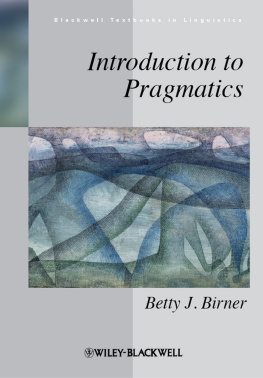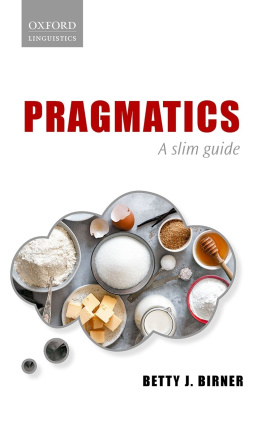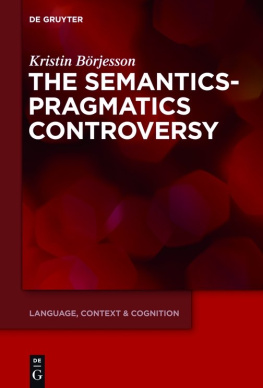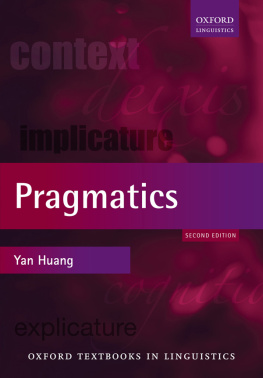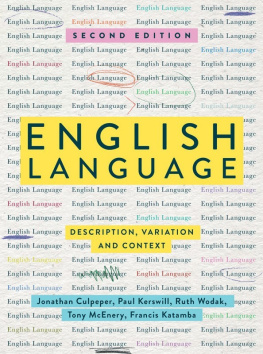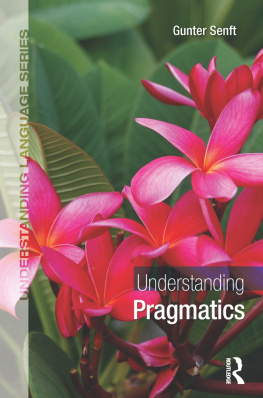
Blackwell Textbooks in Linguistics
The books included in this series provide comprehensive accounts of some of the most central and most rapidly developing areas of research in linguistics. Intended primarily for introductory and post-introductory students, they include exercises, discussion points, and suggestions for further reading.
Liliane Haegeman, Introduction to Government and Binding Theory (Second Edition)
Andrew Spencer, Morphological Theory
Helen Goodluck, Language Acquisition
Ronald Wardhaugh, An Introduction to Sociolinguistics (Sixth Edition)
Martin Atkinson, Childrens Syntax
Diane Blakemore, Understanding Utterances
Michael Kenstowicz, Phonology in Generative Grammar
Deborah Schiffrin, Approaches to Discourse
John Clark, Colin Yallop, and Janet Fletcher, An Introduction to Phonetics and Phonology (Third Edition)
Natsuko Tsujimura, An Introduction to Japanese Linguistics (Second Edition)
Robert D. Borsley, Modern Phrase Structure Grammar
Nigel Fabb, Linguistics and Literature
Irene Heim and Angelika Kratzer, Semantics in Generative Grammar
Liliane Haegeman and Jacqueline Guron, English Grammar: A Generative Perspective
Stephen Crain and Diane Lillo-Martin, An Introduction to Linguistic Theory and Language Acquisition
Joan Bresnan, Lexical-Functional Syntax
Barbara A. Fennell, A History of English: A Sociolinguistic Approach
Henry Rogers, Writing Systems: A Linguistic Approach
Benjamin W. Fortson IV, Indo-European Language and Culture: An Introduction (Second Edition)
Liliane Haegeman, Thinking Syntactically: A Guide to Argumentation and Analysis
Mark Hale, Historical Linguistics: Theory and Method
Henning Reetz and Allard Jongman , Phonetics: Transcription, Production, Acoustics and Perception
Bruce Hayes, Introductory Phonology
Betty J. Birner, Introduction to Pragmatics
This edition first published 2013
2013 Betty J. Birner
Blackwell Publishing was acquired by John Wiley & Sons in February 2007. Blackwells publishing program has been merged with Wileys global Scientific, Technical, and Medical business to form Wiley-Blackwell.
Registered Office
John Wiley & Sons Ltd, The Atrium, Southern Gate, Chichester, West Sussex, PO19 8SQ, UK
Editorial Offices
350 Main Street, Malden, MA 02148-5020, USA
9600 Garsington Road, Oxford, OX4 2DQ, UK
The Atrium, Southern Gate, Chichester, West Sussex, PO19 8SQ, UK
For details of our global editorial offices, for customer services, and for information about how to apply for permission to reuse the copyright material in this book please see our website at www.wiley.com/wiley-blackwell.
The right of Betty J. Birner to be identified as the author of this work has been asserted in accordance with the UK Copyright, Designs and Patents Act 1988.
All rights reserved. No part of this publication may be reproduced, stored in a retrieval system, or transmitted, in any form or by any means, electronic, mechanical, photocopying, recording or otherwise, except as permitted by the UK Copyright, Designs and Patents Act 1988, without the prior permission of the publisher.
Wiley also publishes its books in a variety of electronic formats. Some content that appears in print may not be available in electronic books.
Designations used by companies to distinguish their products are often claimed as trademarks. All brand names and product names used in this book are trade names, service marks, trademarks or registered trademarks of their respective owners. The publisher is not associated with any product or vendor mentioned in this book. This publication is designed to provide accurate and authoritative information in regard to the subject matter covered. It is sold on the understanding that the publisher is not engaged in rendering professional services. If professional advice or other expert assistance is required, the services of a competent professional should be sought.
Library of Congress Cataloging-in-Publication Data
Birner, Betty J.
Introduction to pragmatics / Betty J. Birner.
pages cm
Includes bibliographical references and index.
ISBN 978-1-4051-7582-1 (cloth) ISBN 978-1-4051-7583-8 (pbk.)
1. Pragmatics.
P99.4.P72B57 2013
401'.45dc23
2012005347
A catalogue record for this book is available from the British Library.
Cover image: Paul Klee, Rainy Day (detail), 1931 (no 150), oil and pen & brush and coloured ink on gessoed burlap. Private Collection/ Photo Christies Images/ The Bridgeman Art Library.
Cover design by Nicki Averill Design.
For Andrew and Suzanne,
my two favorite people
Preface
Introduction to Pragmatics provides a thorough grounding in pragmatic theory for graduate students and upper-level undergraduates. While ideally the reader will come to it with a basic understanding of the principles of linguistic analysis, the text assumes little or no prior study of linguistics, and hence should be appropriate for students at all levels of expertise. In length, depth, and scope, it is suitable for a semester- or quarter-long course in linguistic pragmatics.
Pragmatics is a field that is in many ways grounded in semantics. Many of its fundamental principles have been developed in reaction to semantic principles or problems of semantic analysis; for example, Grice developed his theory of implicature in order to address the semantic analysis of the natural-language equivalents of the logical operators (such as and and or ). Since its inception as a field, pragmatics has been in conversation with, and defined in opposition to, the field of semantics. The question of how pragmatics relates to, and differs from, semantics constitutes a thread running throughout this textbook. Different schools of pragmatics differ with respect to how they draw the boundary between semantics and pragmatics, a question with important ramifications for the analysis of natural language. For this reason, this question constitutes a recurring theme in this book. The text begins, therefore, with a quick review of the semantic principles and logical notation that the student will encounter in later chapters, and a discussion of the issues surrounding the demarcation of the fields of semantics and pragmatics. The text goes on to present the time-honored basic concepts of pragmatics such as implicature, speech acts, presupposition, and deixis while also including more recent developments in areas such as neo-Gricean pragmatics, Relevance theory, information structure, and Discourse Representation Theory.
Organization of the Book
The text consists of 10 chapters, a references section, a sources for examples section, and an index. More fundamental concepts are presented earlier, with later chapters building on topics introduced earlier; for instance, the chapter detailing Grices theory of implicature is followed by a chapter in which more recent approaches to implicature are discussed in light of developments over the decades since Grices initial work on the topic. Interdisciplinary strands are woven throughout the text, as the interrelationships between pragmatics and philosophy, syntax, semantics, and even more applied fields such as law and artificial intelligence are explored. Each chapter ends with exercises and discussion questions. These are designed not only to reinforce the students learning of the material in the chapter, but also to extend these concepts in new directions, for example by asking students to consider new variations on the chapters theme, examine apparent counterexamples, or apply theoretical concepts to examples from their own life.
Next page
